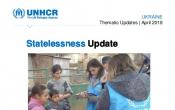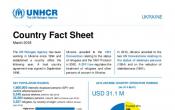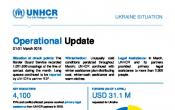Ukraine
For information on UNHCR’s operations in Ukraine prior to 2016, please visit the Regional Office in Ukraine page.
Operation: Ukraine
Location
{"longitude":31,"latitude":49,"zoom_level":5,"iso_codes":"'UKR'"}
By clicking on the icons on the map, additional information is displayed.
Key Figures
| 2017 year-end results | |
| 70,710 | IDPs received core relief, much of it related to winterization (distribution of coal, winter clothing); and 5,521 received cash support |
| 1,870 | and 493 refugees and asylum-seekers received in-kind and cash assistance respectively |
| 34,880 | IDPs and 2,154 refugees and asylum-seekers and 684 stateless persons received legal assistance |
| 7,680 | IDP households received either support to repair their houses or long-term permanent shelter |
| 440 | stateless persons received advice on acquisition or confirmation of nationality |
| 2018 planning figures | |
| 100% | of primary school-aged refugee children will be enrolled in primary education |
| 90% | of refugees and asylum-seekers will have access to national/government primary health care facilities |
| 70% | of internally displaced households will be living in adequate dwellings |
| 12,000 | IDPs will receive cash grants and another 5,000 IDPs will be provided with non-cash support |
| 9,600 | IDPs will receive shelter support and 6,500 IDPs’ shelters will be repaired or materials for maintenance will be provided |
Latest Updates and Related Links
People of Concern
| 2016 | 1,845,246 |

[["Refugees",3302],["Asylum-seekers",6573],["IDPs",1800000],["Returned refugees",8],["Stateless",35363]]
Loading ...
Ukraine
< Back
2017
{"categories":[2013,2014,2015,2016,2017,2018],"budget":[null,null,null,42.25391395,37.63801174,31.0839244],"expenditure":[null,null,null,24.60120571,21.42935972,null]}
{"categories":[2013,2014,2015,2016,2017,2018],"p1":[null,null,null,7.1968692,6.77442765,6.02906483],"p2":[null,null,null,0.66575082,0.63256648,0.81396305],"p3":[null,null,null,null,null,null],"p4":[null,null,null,34.39129393,30.23101761,24.24089652]}
{"categories":[2013,2014,2015,2016,2017,2018],"p1":[null,null,null,5.4217403,4.82198014,null],"p2":[null,null,null,0.0711454,0.31401169,null],"p3":[null,null,null,null,null,null],"p4":[null,null,null,19.10832001,16.29336789,null]}
Loading ...
CHOOSE A YEAR
- 2016
- 2017
- 2018
Operational context
Frequent violations of the ceasefire in eastern Ukraine through 2017 continued to cause casualties, with a 6 per cent increase compared to 2016. Furthermore, damage to infrastructure and properties took place mostly along the contact line, with over 1,500 houses damaged in the government controlled areas (GCA) side alone. Increased insecurity continued to hamper humanitarian access, particularly in non-government controlled areas (NGCA) where access remained highly unpredictable. Despite insecurity, some 800,000 people continued to live within 20 kilometres on both sides of the line of contact. Some returns to these areas were witnessed, mainly by people who did not have sufficient resources to continue living in other areas of Ukraine.Several factors contributed to a sharpening of humanitarian needs for internally displaced and conflict-affected people, despite assumptions that the protection environment would gradually improve; the ongoing armed conflict, restrictions on freedom of movement, imposition of a trade blockade between the GCA and NGCA, difficulties accessing documentation, and continued suspension of social benefits and pensions to thousands of people.
In a positive development, Ukraine adopted a strategy on durable solutions at the end of the year, and UNHCR will contribute to the development of an action plan for its implementation. However, there was little progress on key issues such as payment of pensions and social benefits to people residing in NGCA, making the system of birth registration more responsive to the needs of parents in NGCA, or improving freedom of movement through the checkpoints where queues remained long and conditions remained poor.
Population trends
As of the end of 2017, Ukraine hosted close to 3,260 refugees and some 4,090 asylum-seekers. The majority originate from Afghanistan and Syria, while some 70 other countries of origin are also represented. The number of stateless persons was estimated at some 35,000 at the end of the year.As of August 2017, the Government had registered more than 1,586,400 IDPs. The UN and humanitarian response partners use a planning figure of 0.8 to 1 million IDPs. In addition, there are some 136,400 Ukrainian refugees and close to 17,800 Ukrainians with their asylum claims pending by the end of 2017 in neighbouring countries and the European Union.
Key achievements
UNHCR, as part of the inter-agency response and in line with the 2017 Humanitarian Response Plan (HRP), focused on three main objectives: i) advocate for and respond to the protection needs of conflict-affected people with due regard to international norms and standards; ii) provide emergency assistance and ensure nondiscriminatory access to quality essential services for populations in need; and iii) improve the resilience of conflict-affected people, prevent further degradation of the humanitarian situation and promote recovery and social cohesion. In 2017, UNHCR continued to lead the protection cluster and co-led the shelter/NFI cluster.Against this background, the key achievements of UNHCR’s operation in Ukraine included the following:
- A Multi-year, Multi-partner protection and durable solutions strategy to cover the period 2018-2022 was developed. The strategy foresees different operational approaches in three distinct geographic areas. Along the contact line and in non-Governmental Controlled Areas (NGCA), UNHCR will focus on humanitarian protection. In the rest of Ukraine, UNHCR will concentrate on protection and durable solutions for IDPs while preparing for responsible disengagement, as well as on protection and solutions for refugees and stateless persons.
- Legal assistance was provided to more than 37,700 refugees, stateless persons and IDPs through a network of partner lawyers and advocates operating throughout Ukraine, including in some detention centres. Counselling was provided on a variety of issues, with matters related to the asylum procedure, payment of social benefits and pensions, registration, documentation, freedom of movement and housing land and property rights featuring.
- Authorities were supported in conducting consultations for the development of an IDP durable solutions strategy, which was ultimately adopted at the end of 2017. UNHCR also began to contribute to development actors’ work on establishing an affordable housing project for IDPs.
- A total of 1,170 shelters were repaired (nearly 30% in NGCA) with a breakdown of 423 light repairs, 548 medium repairs, 164 heavy repairs and 34 reconstructions. The repairs targeted vulnerable families who remained in (or planned to return to) houses damaged during the conflict.
- Through a new agreement with the Ukrainian postal service, winter cash assistance (for purchasing fuel for heating) was provided to some 840 people of concern (including 90 people with disabilities) in the last quarter of the year when additional funds became available. In addition, more than 70,700 people benefited from in-kind assistance in 2017, much of it related to winterization (distribution of coal, winter clothing).
- Building on the existing strengths of Ukraine’s civil society, UNHCR also provided support to some 320 community groups engaged in protection and assistance to IDPs and conflict-affected persons. During 2017, 43 ‘quick impact projects’ aiming to promote peaceful coexistence between IDPs and hosting communities were implemented, out of which 25 in the government-controlled areas of eastern Ukraine.
Unmet needs
Access to NGCA remained restricted and constrained the timely delivery of assistance.Since the beginning of the crisis, 9,000 repairs have been made in NGCAs. Prior to the start of 2017, the conservative estimation in the absence of a systematic verification of damage was between 10,000 and 12,000 houses, while the number could be up to three times higher. In GCAs, the shelter cluster estimates that over 10,000 households, including a backlog of homes damaged in 2015-2016, still require repairs. Between March and August 2017, a flare up in hostilities caused new damage to over 700 houses.
In addition to UNHCR’s capacity-building and advocacy efforts, gaps in meeting humanitarian needs remain.
There is a need for continued support to people with specific needs, primarily through cash assistance. If more funds were available, UNHCR could have assisted an additional 600 people and implement some 20 more ‘quick impact projects’.
Asylum-seekers do not have the right to work in Ukraine, and there are few spaces available in temporary accommodation centers. As a result, most have to find irregular jobs or rely on the very limited financial assistance provided by UNHCR. Due to budgetary constraints, UNHCR is also unable to provide at a larger scale Ukrainian language classes and assistance to employment or other means for self-reliance.
Working environment
As of mid-2016, more than 1.6 million people were registered by the Government as internally displaced. UN agencies use a triangulated IDP figure of approximately 800,000 to 1,000,000, as outlined in the “2016 Ukraine humanitarian response plan”. UNHCR’s response forms part of inter-agency efforts and focuses on three main objectives: firstly, advocating for and responding to the protection needs of conflict-affected people; secondly, providing emergency assistance and ensuring non-discriminatory access to quality essential services; and thirdly, improving the resilience of people of concern, preventing further degradation of the humanitarian situation, and promoting early recovery and social cohesion.
UNHCR continues to lead the shelter/non-food item (NFI) and the protection clusters. The security situation in eastern Ukraine remains volatile and can hinder delivery of humanitarian assistance to people in need. It is hoped that the resolution of obstacles to humanitarian access in non-government controlled areas will enable UNHCR to enhance its assistance delivery.
There remain challenges in securing protection and durable solutions for IDPs, including restrictions on freedom of movement and humanitarian access to affected populations. Long delays, including overnight, at crossing points put civilians at risk, especially people with specific needs. UNHCR continues to call for measures to facilitate and expedite crossings. The situation of people residing on both sides of the line of contact remains especially concerning, as they lack access to services and protection, with delivery of humanitarian and medical aid severely restricted due to security issues and administrative obstacles. UNHCR is particularly concerned about the suspension of social benefits and pensions for IDPs, and urges that these entitlements be de-linked from IDP registration and related benefits, noting that such payments are an acquired right of all citizens. UNHCR continues to work closely with community-based organizations to support IDPs and people at risk of displacement.
Although no major new displacement is expected in 2017, in view of the challenging economic situation, many residents of non-government controlled areas may continue to move to government-controlled areas or to commute across the line of contact. Some spontaneous returns are also expected, including by people who have sought refuge or other forms of legal stay in neighboring countries. It is assumed that the number of IDPs will slightly decrease, while the number of returnees may increase.
As of mid-2016, Ukraine was hosting some 3,200 refugees and 6,400 asylum-seekers. The majority of refugees and asylum-seekers originated from Afghanistan and the Syrian Arab Republic, with more than 70 other countries of origin also represented. More than 35,000 people were estimated to be stateless as of mid-2016. UNHCR will continue to work with the Government to bring the national asylum system in line with international standards, including in terms of prospects for local integration of refugees. Several important legislative initiatives relating to the asylum system have been recently adopted, such as the inclusion of asylum issues in the national human rights strategy and its action plan, and measures to strengthen asylum procedures.
Key priorities:
In 2017 UNHCR will focus on:
• continuing to lead the shelter/NFI and the protection clusters, and fostering partnerships with IDP communities, international organizations, civil society, and central and local governments;
• consolidating UNHCR’s presence in areas with large numbers of IDPs;
• maintaining a strong protection monitoring and advocacy role and promoting access to durable solutions for IDPs;
• responding to protection concerns of and acute humanitarian gaps faced by IDPs and vulnerable populations/communities by: providing cash grants, legal and social counselling, as well as life-saving NFIs and shelter support for those at highest risk; implementing community projects for persons with specific needs in non-government controlled areas and along the contact line; supporting “quick-impact” projects aimed at fostering peaceful coexistence between IDPs and host communities;
• ensuring the continuing participation of the Government in the regional Quality Initiative in Eastern Europe and the South Caucasus (Phase II), with the aim of strengthening asylum procedures by conducting capacity building for first instance decision makers, the judiciary, and border guards; and
• supporting the Government in the identification of stateless people and developing relevant legislation to combat statelessness, including through the establishment of a statelessness determination procedure.





